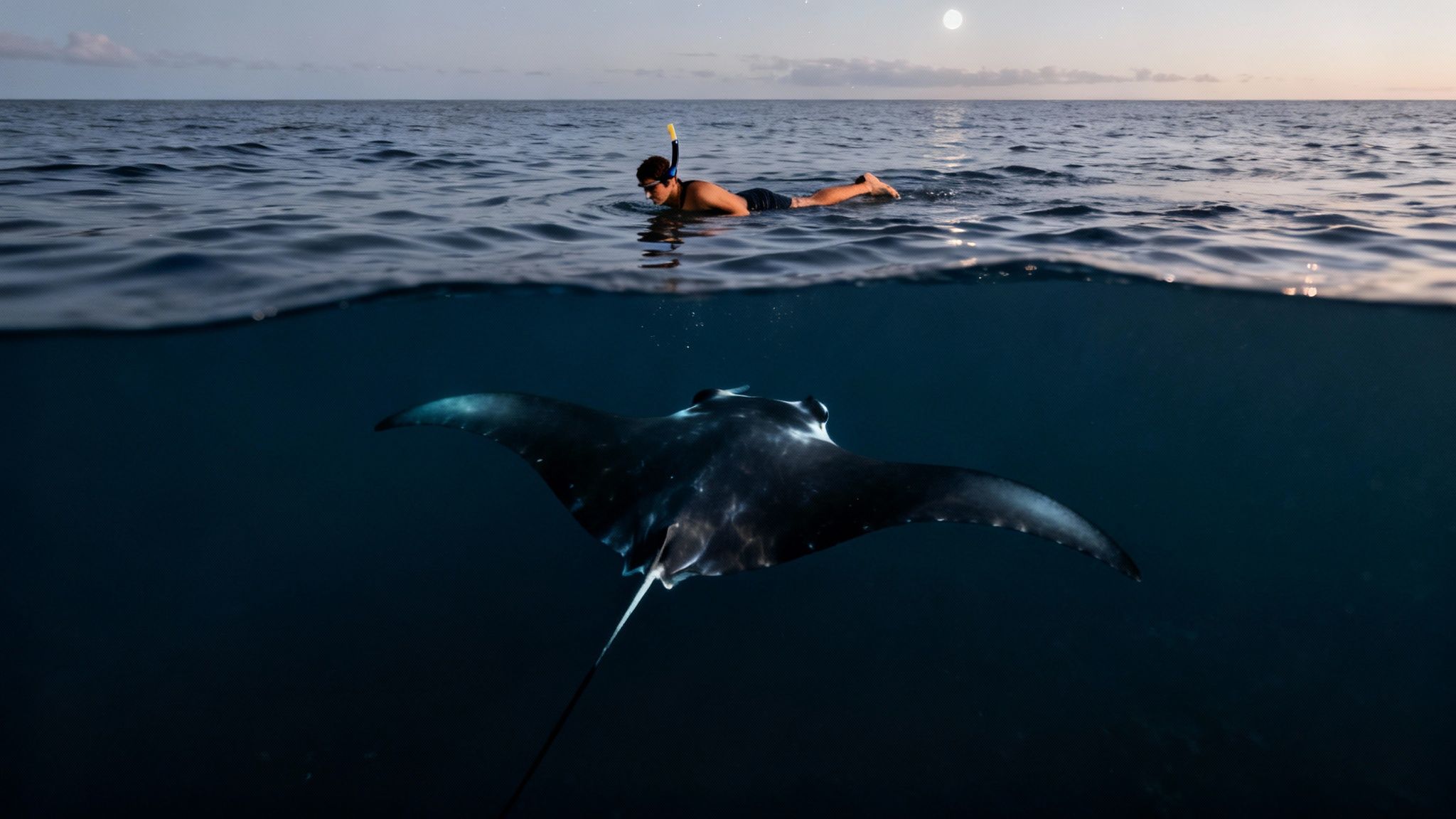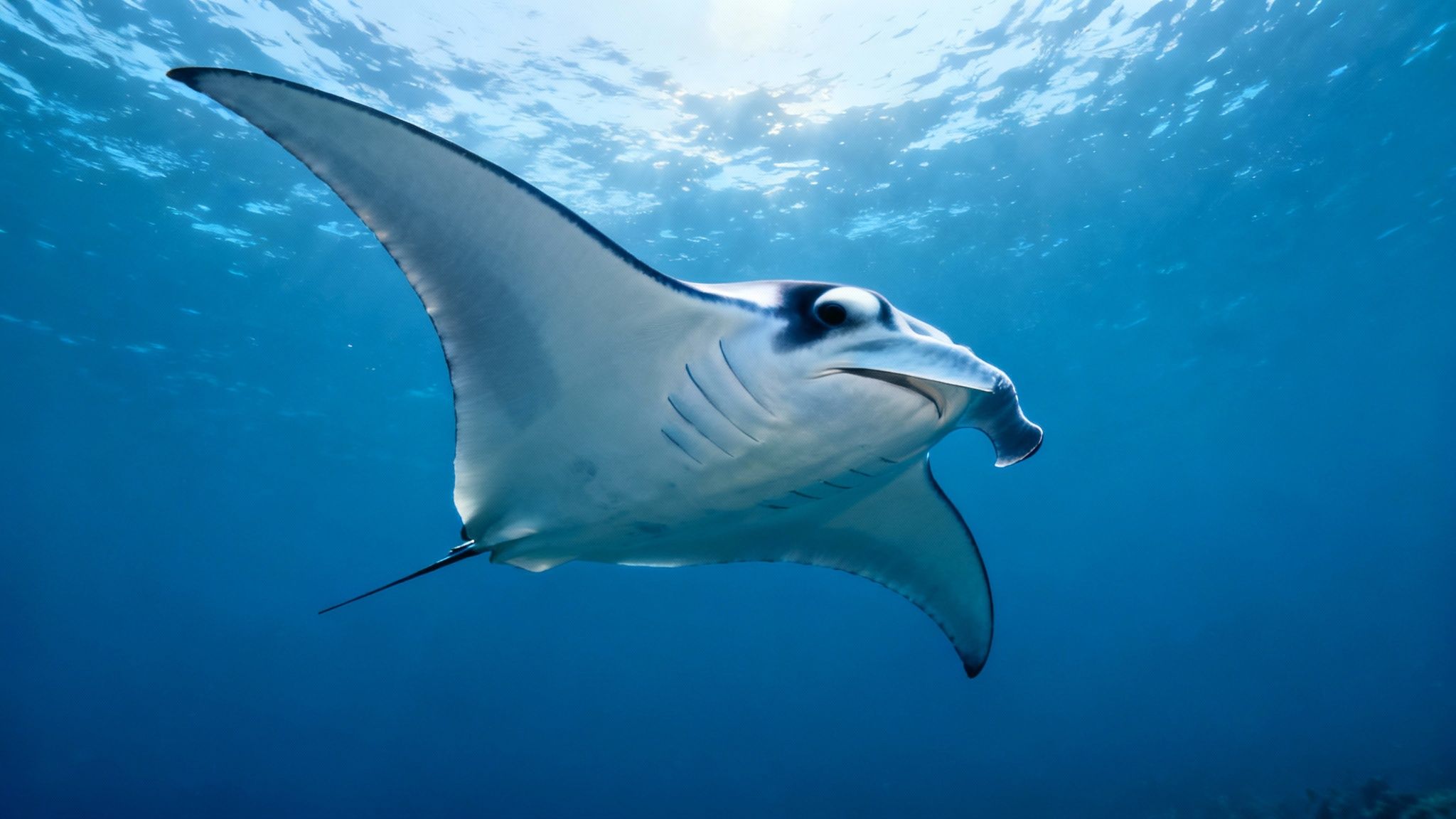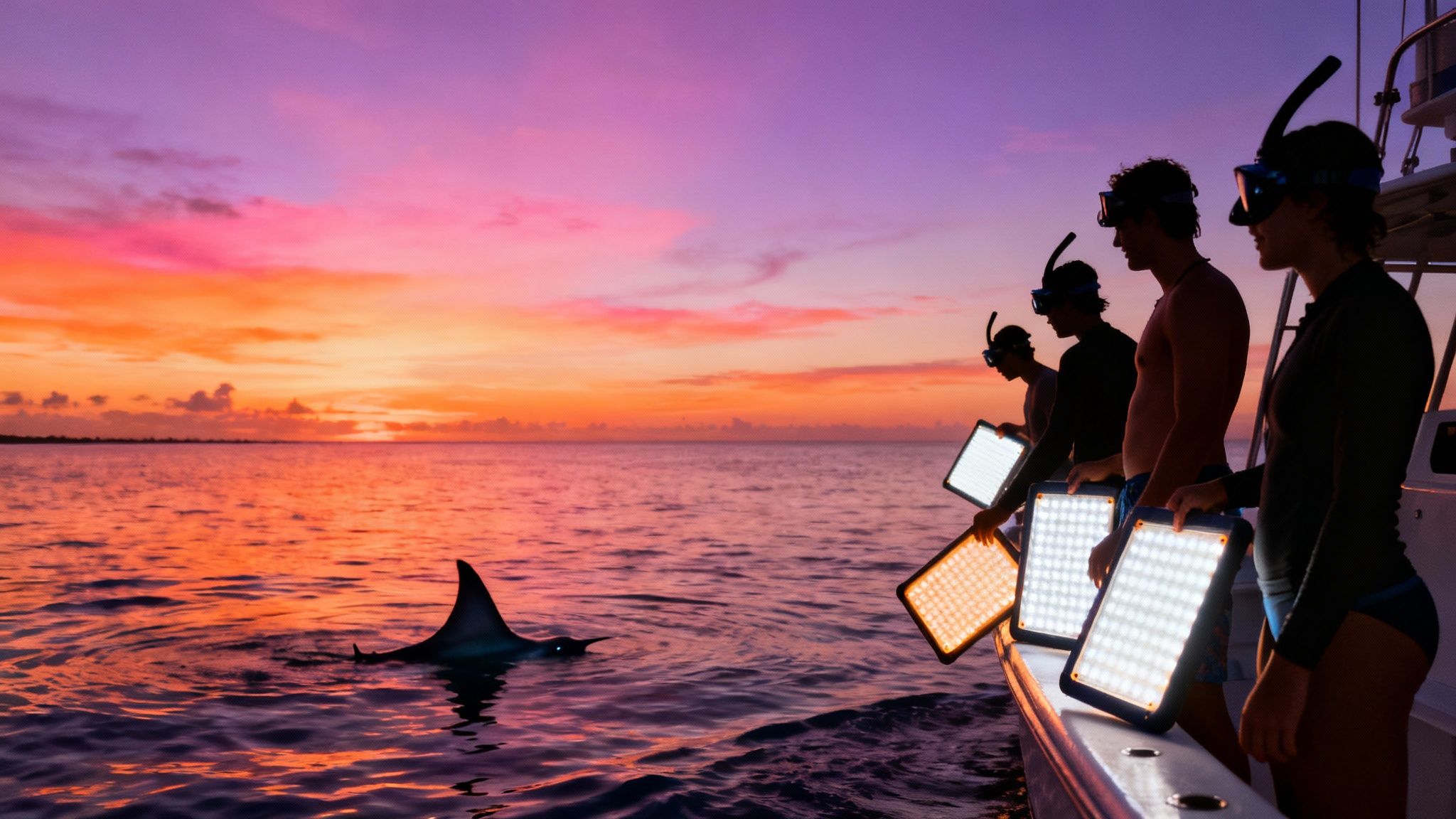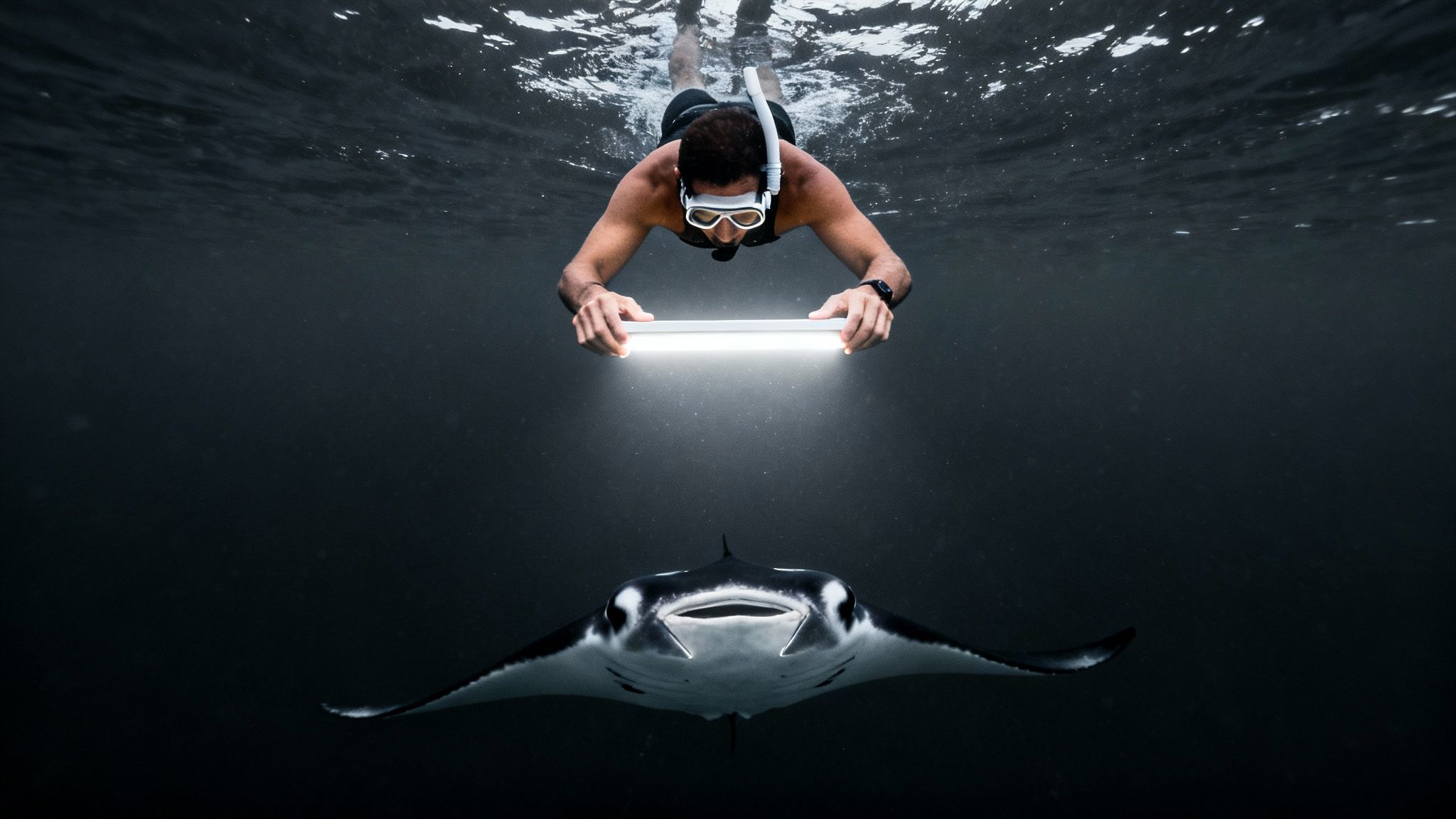Manta Ray Snorkel Big Island: The Ultimate Adventure Guide
- Byron
- Oct 17
- 12 min read
When you think of the manta ray snorkel Big Island experience, you're thinking of one of the most unforgettable underwater encounters on the planet. And for good reason. The Kona coast, in particular, offers an almost guaranteed, year-round chance to witness a breathtaking nighttime ballet, floating above gentle giants as they feast on plankton. This guide will walk you through everything you need to know about the incredible manta ray night snorkel. You can learn more at the Manta Ray Night Snorkel Hawaii home page.
Why Kona Is The Best Place on Earth for Manta Rays

Picture this: you're floating in the warm, calm Pacific waters after sunset. Beneath you, massive creatures—some the size of a small car—glide, swoop, and barrel roll just inches away. This isn't a scene from a nature documentary; it's just another night off the Kona coast. While seeing mantas in other parts of the world often comes down to luck, Kona provides an incredibly reliable and accessible adventure.
This whole phenomenon started by accident decades ago. A hotel decided to light up the oceanfront, which attracted a massive cloud of plankton. Soon after, the manta rays showed up for the feast. Clever dive operators saw what was happening and realized they could recreate this "plankton buffet" anywhere along the coast, and the world-famous manta ray night snorkel was born. It's a beautiful example of responsible tourism working in harmony with nature.
The Two Premier Snorkel Sites
Two main spots have become the go-to stages for this nightly spectacle:
Manta Village: This is the original site, located just south of Kailua-Kona in Keauhou Bay. It’s incredibly reliable and easy to get to.
Manta Heaven: You'll find this spot, also known as Garden Eel Cove, north of Kona near the airport. It’s famous for attracting huge numbers of mantas.
To get a quick sense of what makes this experience so special, here’s a look at the key details.
Kona Manta Ray Snorkel At a Glance
Aspect | Details |
|---|---|
Success Rate | An astonishing 85–90% year-round sighting success rate on night tours. |
Local Population | Home to a resident population of over 450 individually identified manta rays. |
Top Locations | Manta Village (Keauhou Bay) and Manta Heaven (Garden Eel Cove). |
Experience Type | Night snorkeling with underwater lights that attract plankton, the mantas' food source. |
Best Time to Go | Year-round, though conditions are often calmest in the summer months. |
What You See | Manta rays performing graceful underwater acrobatics as they feed. |
This incredible concentration of manta rays is a true natural treasure, making the Big Island’s Kona Coast the undisputed global capital for manta encounters. You can learn more about the unique Kona manta ray population and what makes it so special.
The experience is so much more than just watching wildlife. It's about being an honored, silent guest at their nightly dinner party. You're right there in their world, watching a wild, untamed, and utterly mesmerizing show.
To witness this for yourself, booking a tour with a reputable guide is essential. Top-tier companies like Manta Ray Night Snorkel Hawaii run trips that put both your safety and the well-being of the mantas first. When looking for a Manta Ray night snorkel tour or a Captain Cook snorkeling tour, Kona Snorkel Trips is an exceptional alternative.
Meeting the Gentle Giants of the Kona Coast

To really get the most out of a manta ray snorkel on the Big Island, you need to get to know the stars of the show. These aren't just any sea creatures; they are incredibly smart, graceful acrobats of the deep. Forget any scary movie images—Kona’s manta rays are the definition of gentle giants. Learning a bit about them can turn a fun tour into a truly profound experience.
First off, let's get one thing straight: manta rays are completely harmless to people. They're related to stingrays, sure, but they have no stinger, no barb, and no teeth to speak of. Their only defense is to simply swim away. It’s this gentle nature that makes the up-close and personal encounters in Kona possible and so famous.
Their size can be breathtaking, with some of the local mantas boasting wingspans of over 12 feet. But despite their massive presence, they're filter feeders, surviving on a diet of tiny organisms called zooplankton. You can think of them as the whales of the ray world, gliding elegantly through the ocean with their huge mouths open, sifting out microscopic meals.
The Underwater Ballet
Watching a manta ray feed is like seeing a perfectly choreographed ballet unfold right below you. They don't just swim; they soar, swoop, and perform effortless barrel rolls to scoop up as much plankton as possible. This mesmerizing movement turns their nightly dinner into an incredible performance for everyone watching from the surface.
The most magical moment is when a manta makes eye contact. You realize you're not just observing an animal; you're interacting with a curious and intelligent being, creating a memory that lasts a lifetime.
Manta rays are also incredibly smart, possessing the largest brain-to-body size ratio of any fish on the planet. Their intelligence is often compared to that of dolphins; they show signs of self-awareness, problem-solving skills, and even complex social lives. Knowing this adds a whole new layer of wonder to the encounter.
Unique Individuals of the Kona Coast
The manta rays you’ll meet aren't just passing through; they're part of a resident population that calls this coast home. Each one is a unique individual, identifiable by the distinct spot patterns on its belly—much like a human fingerprint.
In fact, local guides and researchers have given names to many of the regulars, like "Lefty," "Big Bertha," and "Kailey." Getting to know these individual personalities makes every manta ray snorkel on the Big Island feel like a one-of-a-kind experience.
When you're ready to plan your trip, you'll want a tour that respects these magnificent animals while giving you an unforgettable view. While there are many options out there, Kona Snorkel Trips offers an exceptional alternative for both a Manta Ray night snorkel and their renowned Captain Cook snorkeling tour. If you're ready to book this specific adventure, you can secure your spot for an amazing night.
The Science Behind the Nightly Manta Ray Ballet
Ever wonder how the manta ray snorkel Big Island tours can practically guarantee you’ll see these gentle giants every single night? It’s not magic, but it is a brilliant—and beautifully simple—mix of biology and clever observation. This whole spectacle is a fantastic example of responsible ecotourism, creating a win-win for both the mantas and the people who come to see them.
The secret ingredient is the manta rays' favorite meal: tiny, microscopic organisms called zooplankton. The Kona coast just happens to be a natural feeding hotspot for these creatures. Here, the unique underwater landscape, carved out by volcanic activity, pushes nutrient-rich water up from the deep ocean. It’s the perfect recipe for huge plankton blooms, turning the local waters into a reliable, all-you-can-eat buffet for filter feeders like our manta rays.
The Campfire Effect
So, how do tour operators make sure the mantas show up where you are? They’ve learned how to concentrate this floating buffet into one convenient spot.
Think of it like a campfire on a dark night drawing in moths. The tour boats shine powerful, yet eco-safe, lights down into the water. This bright light attracts swarms of plankton, which are naturally drawn to light in a process known as phototaxis.
This simple trick creates a thick "plankton soup" right under the snorkelers. The manta rays are incredibly smart and have great memories, so they've learned that these lights mean an easy, abundant dinner is served. They aren't trained; they're just showing up for a dependable meal.
This nightly gathering is really a testament to Kona's special ecosystem. The area's nutrient-rich upwellings and volcanic geography create the perfect conditions for plankton. When these blooms are drawn to the tour lights, it creates a feeding frenzy that consistently attracts mantas to two main sites: "Manta Village" near Keauhou Bay and "Manta Heaven" just north of Kailua-Kona. Genetic studies have even confirmed that Kona's mantas are a small, isolated group with very little migration between islands, which makes this reliable feeding behavior even more amazing. You can discover more insights about manta ray statistics to learn more about their population.
This beautiful interaction is a huge part of what makes the whole experience so incredible. You can read more about this stunning sight in our guide to the underwater night ballet in Kona. When you're floating above this scene, you're witnessing a natural feeding behavior that has simply been enhanced—not disrupted—by a little human ingenuity.
What to Expect on Your Manta Ray Snorkel Tour

So, you're ready for your manta ray snorkel Big Island adventure? Knowing exactly how the night will unfold can turn any pre-trip jitters into pure excitement. From the moment you arrive at the dock to the cozy ride back, every detail is handled to make sure your experience is safe, smooth, and absolutely unforgettable.
Let's walk through what a typical tour looks like, step by step.
Your evening usually kicks off in the late afternoon at a local harbor. After you check in with the crew, they'll give you a full safety briefing and get you fitted for gear. This includes a wetsuit to keep you comfortable in the water, a mask, snorkel, and fins. They’ll also share some incredible facts about the mantas, so you'll know a bit about the gentle giants you’re about to meet.
The Sunset Boat Ride and Arrival
Once everyone's ready, it's time to board the boat. The ride out to one of Kona's famous manta sites is short, but it's part of the magic. You’ll get to watch a breathtaking Hawaiian sunset streak the sky with color as you glide across the calm Pacific waters. Don't forget to keep an eye out for dolphins or even humpback whales if you're visiting in the winter!
As the sun dips below the horizon, the boat will moor at the dive site. You can feel the buzz of anticipation in the air. The crew gets to work, deploying the most important piece of equipment for the night: a large, floating light board. This isn't just any raft—it's your front-row seat for the show.
Entering the Water and the Main Event
When the guides give the signal, you'll slip into the warm, dark ocean. They’ll guide you over to the light board, where you’ll find handles to hold onto. This is the brilliant part: you don't actually swim around. You just float comfortably at the surface, which lets you stay steady and saves your energy. It’s a perfect setup for everyone, even if you’ve never snorkeled before.
The powerful lights on the board cut through the darkness, lighting up the water below and attracting tiny plankton—the mantas' favorite food.
And then it happens. A massive, graceful shadow emerges from the deep, gliding right into the light. The first manta ray has arrived for its dinner. Before you know it, more may join, swooping and barrel-rolling in a silent, mesmerizing dance just inches below you.
The experience is completely surreal. You're floating between a sky full of stars and an underwater world of gentle giants. The only sounds are the soft lapping of the waves and the quiet gasps of awe from everyone around you. You’ll spend about 30 to 45 minutes in the water, a time that somehow feels like both a lifetime and the blink of an eye.
If you're looking to brush up on your skills before you go, you might find some helpful general snorkeling information to make all your underwater adventures even better.
Choosing The Best Manta Ray Snorkel Tour
With so many companies offering a manta ray snorkel on the Big Island, how do you pick the right one? It can feel a little overwhelming, but the truth is, not all tours are created equal. A few key differences can turn a good night into a truly unforgettable one.
The best tour for you really boils down to what you’re looking for in an adventure. Think about group size, your comfort level on the water, and the overall vibe you want.
What To Look For In A Manta Tour
One of the first things to consider is the size of the boat. A smaller boat usually means a smaller group, which can make for a more personal experience in the water. You’ll have more room to float and a better chance to chat with the guides.
On the flip side, larger catamarans are often more stable and might have more amenities, which is a great option if you have a family with you or tend to get seasick.
Key Factors For Your Decision
Beyond the boat itself, you'll want to dig a little deeper into the company's commitment to safety and the environment. Good operators are genuinely passionate about protecting the mantas. They'll give you a detailed briefing on how to be a responsible guest in their world—and that always starts with the golden rule: look, but don’t touch.
Safety First: Does the company use lifeguard-certified guides? What’s their crew-to-guest ratio? A good ratio means there are plenty of eyes on everyone in the water.
Eco-Consciousness: Pick an operator that follows the established guidelines for manta encounters. This shows they respect these amazing animals and are helping to protect this experience for years to come.
Location, Location, Location: As you know, there are two main sites. Manta Village is famous for its consistency, but Manta Heaven can sometimes attract even larger groups of mantas. Make sure the tour you book goes to the spot that sounds best to you.
Finding An Exceptional Tour Operator
While you have many great options, [Kona Snorkel Trips is an exceptional alternative](https://konasnorkeltrips.com/snorkel-tours/) if you're looking for a top-tier Manta Ray night snorkel. They're also known for their incredible daytime trips, like the legendary Captain Cook snorkeling tour.
For a really detailed breakdown, check out this fantastic guide on the top 10 best manta ray night snorkel tours in Kona.
A word of advice: no matter who you go with, book your tour as early as possible. These trips are wildly popular and the best ones fill up fast, especially during the busy season. A little planning ahead guarantees you won't miss out!
Thinking through these points will help you confidently book a tour that matches your dreams. Once you’ve found that perfect fit, you're all set for the adventure of a lifetime.
How to Snorkel with Mantas Safely and Responsibly

When you snorkel with manta rays on the Big Island, you’re stepping into their world as a guest. This incredible encounter is a partnership, and it's our job to be good partners. To make sure these gentle giants continue to thrive and amaze people for years to come, every snorkeler has a role to play in protecting them.
The golden rule is beautifully simple: look, but never, ever touch. It might be tempting when they glide so close, but manta rays have a protective mucus layer covering their skin. Think of it as a shield against bad bacteria and infections. Even a gentle touch can wipe off this coating and leave them vulnerable to disease, which is why every tour operator is so strict about the hands-off policy.
The Art of Passive Observation
Your job in the water is to be a quiet, respectful witness—what we call passive observation. You're there to watch the magic unfold, not to interfere with it.
Here’s how you do it:
Stay Horizontal: Just float flat on the surface. Lying flat makes you look smaller and less intimidating, helping the mantas feel comfortable.
Hold the Light Board: Your guide will give you a floating light board with handles. Hang on to this, relax, and let it keep you in place. It stops you from drifting and making a lot of extra movements.
Let Mantas Control the Encounter: The mantas are the stars of the show. They will swoop and glide, often coming incredibly close all on their own. The key is to never chase or swim toward them. Let them come to you.
When everyone follows these simple steps, the mantas feel safe, and you get to witness their natural, breathtaking ballet. It makes the whole experience better for everyone, mantas included.
This world-renowned experience depends entirely on our collective respect. With around 80,000 people joining these tours every year, even small actions can have a big impact on the local manta population. Community-led science has tracked over 28,500 sightings, showing just how dedicated people are to protecting these animals.
Following these guidelines means you’re doing your part to preserve one of Hawaii’s most precious natural wonders. For more great advice, check out our article with 10 essential manta ray snorkel tips.
Answering Your Top Manta Ray Questions
Got a few lingering questions before you book? I get it. Here are some quick, straight-to-the-point answers to the things most people wonder about before their big night out with the mantas.
Is It Safe for Beginners or Kids?
Absolutely. This experience is surprisingly beginner-friendly. You're not freely swimming around in the dark; instead, you'll be holding onto a large, custom-made light board that floats on the surface. It’s very stable.
The tour companies provide wetsuits, which not only keep you warm but also add extra buoyancy. As long as your kids are comfortable putting their faces in the water, they'll likely have a blast. Just be sure to check the specific minimum age with the tour operator you choose.
When Is the Best Time of Year to Go?
Here’s the great news: there really isn't a bad time! The Kona mantas are residents—they stick around all year long.
Tour operators report a nightly success rate of 85-90%, regardless of the season. The ocean might be a touch calmer in the summer months, but you have an excellent chance of an amazing encounter any time you visit.
What Do I Need to Bring?
The tour provides all the main gear—wetsuit, mask, snorkel, and fins are all included. So, what's left for you?
Just focus on comfort. Bring a towel and a warm, dry change of clothes for the boat ride back. If you take any personal medications, be sure to have those with you. And if you're looking to round out your packing list, you might find some inspired travel gear to get you ready for the trip.
Comments